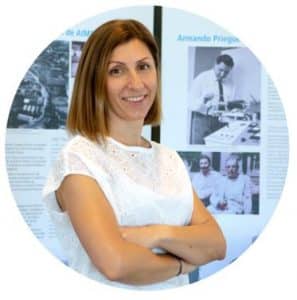Julia Maria Gomez de Avila Segade | 31/01/2023
The decarbonization of strategic sectors is a priority objective of large economies. Industries like aeronautics are relying on innovation to reduce their emissions. We discussed this with Elena Rodríguez, Head of R&D&I at the AIMEN Center for Technology.
Why is decarbonizing the aviation sector such a complicated challenge? What is the context that we find ourselves in?
As economies and populations grow, demand for goods increases, as does the number of people with the desire and means to travel. Globally, total transportation activity is expected to more than double by 2050 relative to 2015. Any technological advancement in aviation decarbonization would be merely offset by increased demand for mobility.
Aviation currently accounts for 2% of global CO2 emissions and 3.8% of emissions in the European Union, but expected growth in air traffic will cause global emissions to triple by 2050.
Against a backdrop of a global commitment to dramatically reduce the impact on the environment, the EU has set ambitious targets (such as climate neutrality by 2050) that have been adopted in aviation, in turn forced to rapidly and broadly adopt a new generation of aircraft with decisive performance improvements. This is a complicated challenge, as it affects the entire value chain of aircraft manufacturing, both when it comes to the development of new lighter structures (new designs and materials) and more sustainable propulsion systems, in addition to the strong inertia in an industry where introducing changes that affect its certification processes is always very cumbersome, entails many years of development, and is therefore very expensive. R&D projects such as CAELESTIS contribute to the introduction of such changes, based on new light component design concepts and new ways of manufacturing from a digital standpoint.
We would like to talk specifically about this European project, CAELESTIS, in which AIMEN is participating. How are the first steps being taken?
The idea stems from the need to ensure comprehensive digitalization of the European industry value chain that enables the optimization of manufacturing processes and the speeding-up of certification for our airframes, demanded as a result of new commitments in sustainability and electrification.
In this sense, CAELESTIS, a project led by AIMEN, will connect the design, simulation and engineering software distributed throughout the value chain to streamline information exchange processes and exploit the capabilities of supercomputers in simulation-based optimization cycles. All of this is validated in a specific case study in which it is also sought to demonstrate the lightening of the airframes and their optimized manufacture, reducing the number of steps during fabrication, with automated and advanced processes. Thus, a new OGV (outlet-guide vane) concept will be developed, a component of the motor that will be multi-material based, lightened, combining additional manufacturing processes with composite processing outside of autoclave.
What are the main goals of this project?
The fundamental objective is to enable the European Union aviation industry to design and manufacture disruptive aircraft engines and airframes with enhanced predictive capabilities so as to expand the design space and reduce the uncertainties potentially encountered throughout the product and engineering lifecycle, which currently raise obstacles to them being brought into service.
Tell us about the different plan participants and what the roadmap is that has been set out.
The project, which began in May 2022 and has a total duration of 42 months, consists of 11 partners located in 8 countries in Europe, companies, centers and universities whose experience is divided into:
- Modeling and simulation of mechanical and manufacturing process performance.
- Interoperability systems, high-performance computing, artificial intelligence and cybersecurity.
- Intelligent and adaptive manufacturing systems for composite and multi-material components.
- Dissemination, communication, exploitation, management of intellectual property and data.
- Aircraft engine
What are the main challenges that are being, or have been, faced?
The initiative is in its first phase, in which mainly the project requirements have been defined, which will seek to improve and shorten the process of bringing parts to market in the aviation industry. This challenge is being solved based on digitalization and virtual prototyping.
To do this, an Interoperable Simulation Ecosystem (ISE) will be developed that will enable bidirectional data flow between the different stages of aerospace part design and manufacturing, with the goal of speeding up the design phase and optimizing production, while ensuring the fabricability of parts and optimizing their design.
This interoperable system will have the following developments:
- A digital thread that will connect the design, simulation, and manufacturing phases of aerospace parts, establishing a two-way data flow between them.
- Digital twins based on design and fabrication models of parts that will account for and manage uncertainty arising from manufacturing processes.
- High Performance Computing (HPC) systems where simulation of the manufacturing process and part behavior will be carried out.
- Intelligent process monitoring and manufacturing control systems that will seek to analyze and reduce the impact of defects on part behavior in-service.
Could you tell us when the research is and what progress has been made?
At this time the requirements of the project developments and demonstrations have been defined, and a preliminary design of the demonstrations and the architecture of the simulation systems has been created. In addition, there is a plan to extract the manufacturing data and implement it in the different simulation models.
The objective is for communication to occur between models, defined in the simulation system architecture, and for the final results to be validated against the actual results obtained in manufacturing.
Currently, work is underway to obtain an initial virtual data stream between simulation models, and to start generating real data through fabrication on a test basis.
On the other hand, the new design of the OGV is being prepared to lighten the current version, proposing new composite materials, introducing additional manufacturing and evolving the automated and advanced processes in order to fabricate the multi-material structure (composite-metal).
What expectations do you have for this coming year?
The project will progress to using actual manufacturing data in the simulation system and validating simulation solutions with actual results. All of this will be supported by high-performance computing (HPC) systems to run simulations, and with artificial intelligence algorithms to create synthetic data that enriches simulations and proposes alternative and optimized design solutions.
In the next year, it is expected to achieve this flow of real data obtained in manufacturing within the simulation system. In the following months of the project, simulations will be optimized until they are validated using actual process and trial data.
If one were to talk about the reduction of emissions in the industry, what insights would you say are there right now and which agents are most important to your success?
By 2035, three promising types of aircraft with alternative propulsion means could offer viable options to conventional carbon-emitting aircraft, while all-electric battery-powered aircraft could allow for a completely emission-free flight over the shorter distances.
Hydrogen, for its part, could be used to electrify aircraft with fuel cells over medium distances, or by direct combustion. The latter could be applied to any aircraft that travels the current distances.
Professional profile…
 Elena Rodríguez Senin is responsible for, and is the Coordinator of the Advanced Materials Business Unit at the AIMEN Center for Technology. With a Bachelor of Science in Chemistry at Santiago de Compostela (Galicia), she first came into contact with the world of Materials Engineering in Madrid, where she received a doctorate from Carlos III University in 2006.
Elena Rodríguez Senin is responsible for, and is the Coordinator of the Advanced Materials Business Unit at the AIMEN Center for Technology. With a Bachelor of Science in Chemistry at Santiago de Compostela (Galicia), she first came into contact with the world of Materials Engineering in Madrid, where she received a doctorate from Carlos III University in 2006.
Shortly after, she joined AIMEN, where she began as a junior technician and, in 2014, was appointed Coordinator of the Advanced Materials Unit within the R&D area, a position she currently holds.
Keep reading… Industrial sustainability starts with design





